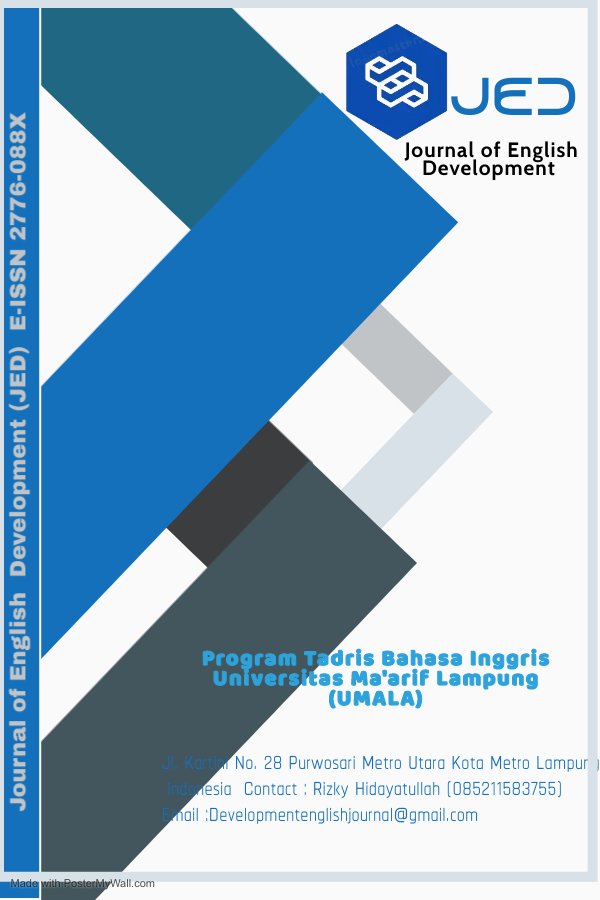Improving The Students' Pronunciation Mastery by Using Pop Songs on The Youtube Music Application
English
DOI:
https://doi.org/10.25217/jed.v4i02.4409Keywords:
YouTube Music; pronunciation; viralAbstract
One of the ways to avoid miscommunication is to pronounce the words correctly. Unfortunately, pronunciation is one of the English aspects that are difficult to learn and teach. The research’s objectives are to know and analyze how the YouTube Music application could improve the eighth grade students’ pronunciation mastery at SMP Negeri 56 Palembang and to find out the causes of the students’ pronunciation problems. It was Classroom Action Research (CAR) with 3 ways of collecting data i.e. test, observation, and questionnaire. It was conducted for class 8.5 at SMP Negeri 56 Palembang. The research reached the successful criteria in the third cycle i.e. 80% of the students reached the KKM. The results showed that by doing the drilling technique, asking the students to sing the song together in some groups, and choosing the appropriate songs e.g. the songs that are viral or happening in the pronunciation classroom activities, the student’s enthusiasm and pronunciation mastery got higher. The lack of exposure to English, the lack of motivation to study English pronunciation, and some English sounds that are hard to pronounce because students do not find them in their native, are the three causes of the students’ pronunciation problems.
References
Aliffia, Yunita, and Yudhi Arifani. 2024. “The The Utilization of Using Youtube Videos to Improve Students Speaking Skills During Online Learning at Ban Kaengsriphoom School, Thailand: English.” Journal of English Development 4(01): 1–14.
Brown, James Dean. 2017. “Forty Years of Doing Second Language Testing, Curriculum, and Research: So What?” Language Teaching 50(2): 276–89.
Celce-Murcia, Marianne, Donna M Brinton, and Janet M Goodwin. 2010. Teaching Pronunciation Hardback with Audio CDs (2): A Course Book and Reference Guide. Cambridge University Press.
Derwing, Tracey M, and Murray J Munro. 2015. Pronunciation Fundamentals: Evidence-Based Perspectives for L2 Teaching and Research. John Benjamins.
Duffy, Peter. 2008. “Using Youtube: Strategies for Using New Media in Teaching and Learning.” In Enhancing Learning through Technology: Research on Emerging Technologies and Pedagogies, World Scientific, 31–43.
Durand, Júlia. 2023. “Library Music as the Soundtrack of YouTube.” Remediating Sound: Repeatable Culture, YouTube and Music. London: Bloomsbury Academic: 203–22.
Hyun, Helen. 2014. How to Design and Evaluate Research in Education. Mcgraw-hill Education-Europe.
Ivančič, Ivana, and Ivo Fabijanić. 2017. “Structural Development of Oxford Advanced Learners’ Dictionary.” Journal of literature and art studies 7(5): 588–607.
Kelly, G. 2001. “How to Teach Pronunciation. Longman.”
Lenka, Ornerová. 2011. The Use of Pop Songs in the EFL Classroom. diplom. de.
Levis, John M. 2018. Intelligibility, Oral Communication, and the Teaching of Pronunciation. Cambridge University Press.
Mania, Sitti. 2008. “Teknik Non Tes: Telaah Atas Fungsi Wawancara Dan Kuesioner Dalam Evaluasi Pendidikan.” Lentera Pendidikan: Jurnal Ilmu Tarbiyah Dan Keguruan 11(1): 45–54.
Mertler, Craig A. 2024. Action Research: Improving Schools and Empowering Educators. Sage Publications.
Rachmawati, Rina, and Fibria Cahyani. 2020. “The Use of YouTube Videos in Improving Non-English Department Students’ Pronunciation Skills.” Alsuna: Journal of Arabic and English Language 3(2): 83–95.
Saldiraner, Gizem, and Emrah Cinkara. 2021. “Using Songs in Teaching Pronunciation to Young EFL Learners.” PASAA: Journal of Language Teaching and Learning in Thailand 62: 119–41.
Sugiyono. 2016. Metode Penelitian Kuantitatif, Kualitatif, Dan R&D. Alfabeta cv.

Downloads
Published
How to Cite
Issue
Section
License
Copyright (c) 2024 Henny Fitri Wahyuni, Masagus Firdaus, Hanni Yukamana

This work is licensed under a Creative Commons Attribution-ShareAlike 4.0 International License.





